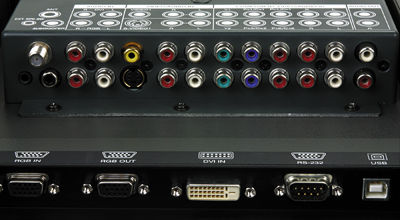Sampo PME-50X6 Plasma HD Monitor
The only thing that's less likely to impress me than a plasma display from a mass-market manufacturer is a lower-priced plasma display from a mass-market manufacturer. Yet Sampo has done just that. At $6,999, the PME-50X6 isn't necessarily cheap, but it is one of (if not the) lowest-priced HD-capable plasma displays on the market, and its image has many impressive qualities. This price point also puts the plasma in the same market as the high-end rear-projection display. Should you extend your search to include this flat-panel model? Read on to find out.

The PME-50X6 incorporates the same bezel design and back-panel layout as Sampo's 42-inch plasma ED monitor (December 2002), but this plasma is 8 inches larger diagonally. The other major difference is that Sampo has moved the front-panel controls to the panel's side for a smooth, uncluttered front. The panel's native 1,366:768 resolution is also a step up from that of the 42-inch model, giving this display more than enough resolution to be considered an HD-capable display.
This model doesn't have a built-in HDTV tuner, so the only way to take advantage of the HD capability is to connect an external HDTV tuner. Fortunately, this is easy to do, thanks to the PME-50X6's numerous connections. Again, these are similar to those found on the 42-inch model and include two component (Y/Pb/Pr) and one each for RGB, DVI (with HDCP), composite, and S-video. All of these connections include audio inputs, although I'd recommend that you use an external audio system. Worst-case scenario: You can at least add a self-powered subwoofer to the built-in speakers via the line-level subwoofer output. For an extra $299, you can get a version of the PME-50X6 that sports an internal NTSC tuner and an RF connection.
A few other back-panel amenities help make it easy to control this plasma. An RS-232 port allows you to connect the display to a Crestron- or AMX-type automation system. If your budget is a bit slimmer, the remote's discrete input commands make it simple to use the display with a Pronto-type programmable remote. Another back-panel connection can trigger various relays when you turn off the display. The manual suggests that you use this function with similarly equipped external speakers. I think it would be more useful, and more impressive, to connect this signal to a line conditioner or voltage regulator. That way, when you turn on the TV, it will trigger the line conditioner, which will power up the rest of your A/V system.

The included remote control is equally easy to use. The basic commands are found on top, and the more-detailed controls hide under a sliding panel. Only the aspect-ratio-control button needs to be more accessible, and separate buttons for each aspect ratio would be a nice idea for the whole industry to consider. As it is, you can toggle through an assortment of modes that will make nearly any program fit the screen. The Sampo doesn't automatically recognize anamorphically transferred DVDs, but neither do most displays.
In conjunction with a calibration-memory-by-input feature, the remote lets you fine-tune the picture for each signal source. In fact, the default settings for the main picture controls (contrast, brightness, color, tint, and sharpness) and the color-temperature settings are available in a separate, semi-hidden but still user-accessible menu (read the manual). You should still hire a qualified professional to perform the calibration, but the dedicated menu means that the technician won't have to wade through numerous adjustments to find the ones he or she needs.
Once you find the right controls, the plasma cooperates nicely. For example, the color decoder is extremely accurate, which means that images are fully saturated, but faces don't look sunburned, and grass doesn't look like it's been watered with radiator coolant. The color-temperature control offers a neutral D6500 setting. In this setting, the display measures a bit blue but not overly so (see the measurements chart). As it is, the image looks quite snappy. If you calibrate the input, you'll be rewarded with an even more vividly colored image. Be careful if you use an external switcher, though. The panel only has one memory setting per input, and it will use the same settings, for example, for both NTSC and HDTV signals. I calibrated the image with 480i DVD signals, which looked outstanding, but I found that HDTV images looked a bit red. If you calibrate the display with 480p signals, HD and DVD signals will look more comparable.













































